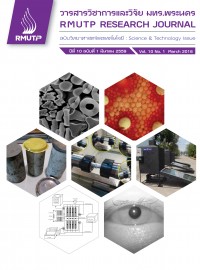อันตรายด้านจุลินทรีย์และจุดควบคุมวิกฤติการผลิตอาหารโรงเรียน : ข้าวคลุกกะปิ
Main Article Content
Abstract
บทคัดย่อ
งานวิจัยมีวัตถุประสงค์เพื่อศึกษาอันตรายด้านจุลินทรีย์ของการผลิตข้าวคลุกกะปิเพื่อบริการในโรงเรียน ประเมินความเสี่ยงและวิเคราะห์จุดควบคุมวิกฤติตามหลักการ HACCP พบว่ากระบวนการผลิตและวิธีการปฏิบัติของผู้ผลิตมีวิธีการปฏิบัติทางสุขลักษณะการผลิตไม่เหมาะสม เนื่องจากผลการวิเคราะห์จุลินทรีย์ในหอมแดงซอย ผักชีหั่นและ พริกขี้หนูซอย พบจำนวนจุลินทรีย์ทั้งหมด (TPC) ปริมาณสูงมีค่าเท่ากับ 1.9×106, 3.2×107 และ 5.9×106 cfu/g และพบเชื้อ E. coli ในผักชีหั่นมากกว่า 1,100 MPN/g ส่วนผสมที่ผ่านความร้อนพบเชื้อ TPC น้อยกว่า 10 cfu/g และตรวจไม่พบเชื้อ S. aureus, C. perfringens, Salmonella และV. parahaemolyticus ข้าวคลุกกะปิพร้อมบริโภคตั้งรอบริการที่อุณหภูมิห้องเวลา 0, 2, 4 และ 6 ชั่วโมง พบจำนวนเชื้อ TPC เพิ่มขึ้นตามระยะเวลาที่เพิ่มขึ้นจาก 1.2×106 cfu/g เป็น 7.6×106, 1.8×107 และ 3.4×108 cfu/g เป็นผลจากส่วนผสมที่ไม่ผ่านความร้อนและกระบวนการคลุกผสมในขั้นตอนการผลิต เมื่อตั้งรอบริการเป็นระยะเวลานานทำให้มีความเสี่ยงต่อการเพิ่มของจำนวนของจุลินทรีย์ จุดควบคุมวิกฤติของการผลิตข้าวคลุกกะปิ ได้แก่ ขั้นตอนการล้างผักสดที่ไม่ผ่านความร้อน การให้ความร้อนในการประกอบอาหารและการตั้งอาหารรอบริการเป็นระยะเวลานานที่อุณหภูมิห้อง
Abstract
The objectives were to study microbiological hazard of Khao kluk ka pi for school food service, risk assessment and critical control points (CCP) according to HACCP principles. The production of Khao kluk ka pi had the improper hygienic practice. Thus, TPC counts were found in shallots, coriander and chilli at 1.9×106, 3.2×107 and 5.9×106 cfu/g respectively and found E. coli in chopped coriander more than 1,100 MPN/g. The TPC, S. aureus, C. perfringens, Salmonella and V. parahaemolyticus were not detected in cooked ingredients. The number of TPC in Khao kluk ka pi held at ambient temperature for 0, 2, 4 and 6 hours were founed an increase from 1.2×106 cfu/g to 7.6×106, 1.8×107 and 3.4×108 cfu/g respectively that was as a result of the uncooked ingredients and mixing process. The microbial numbers were increased when this food was held for a long time before serving. The CCP of Khao kluk ka pi production were indicated at the process of washing raw vegetables, cooking process and holding cooked food at room temperature for a long time before serving.

